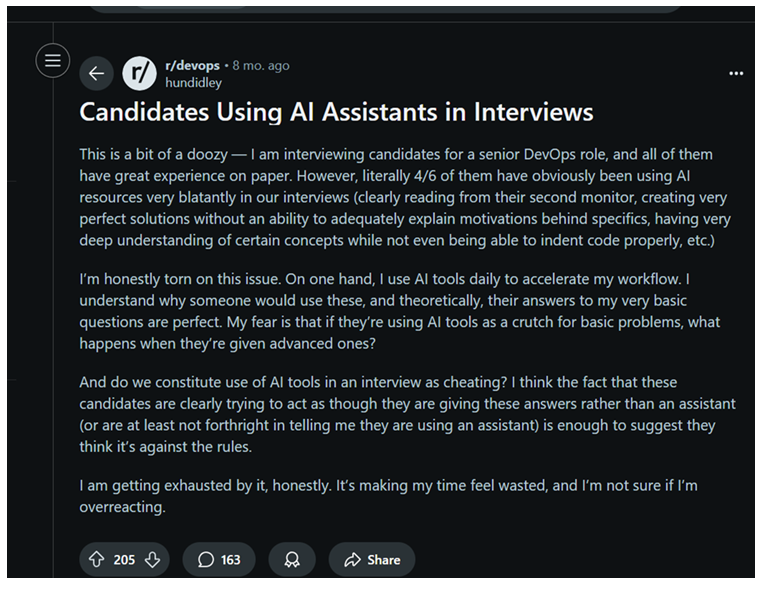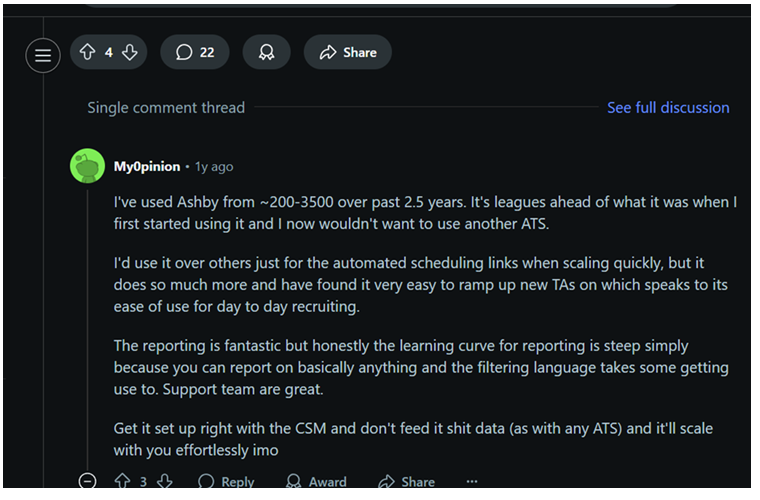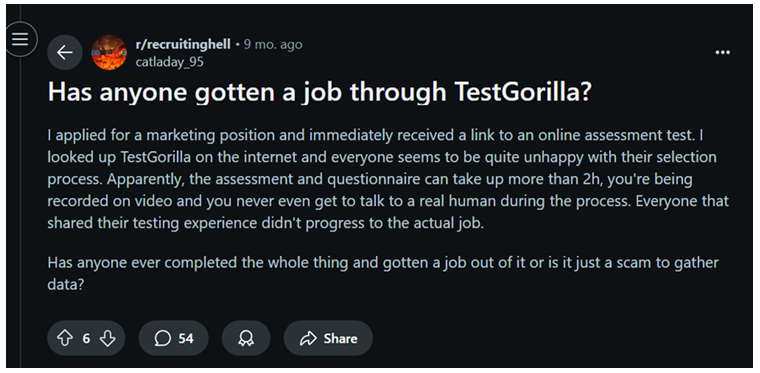Share
Here is what we will cover in this blog post
Introduction: The problem with modern hiring
Stage 1: Create a good job description, use good sourcing sites, and filter effectively
- Create a good job description
- Use good sourcing sites to find high-quality candidates
- Filter effectively
Stage 2: Shortlist and interview candidates
Stage 3: Assign a short skill test (Minimum Viable Task/MVT) and hire with confidence
Introduction: The problem with modern hiring
Finding great talent nowadays feels like trying to spot a star on a cloudy night. If you’re a recruiter, hiring manager, or founder, chances are you’re overwhelmed by a flood of applications and don’t know who is actually qualified for the job.
One of the notable reasons why modern hiring feels broken is AI. You may post a job online and receive hundreds of applications, but very few meet the criteria. This is happening due to AI tools like AIApply and LazyApply, which let candidates apply for hundreds of jobs with a single click. Most résumés are now polished using tools like ChatGPT, Resume AI, or Kickresume, making even unqualified candidates look like top-tier talent.
What used to work—posting a job and waiting for the right person—is no longer effective. This means that in today’s hiring landscape, you can’t rely on résumés alone, and you definitely can’t afford to spend hours sifting through low-effort, AI-generated applications. That’s why we are sharing this 3-step hiring guide—to help you hire smarter, make confident decisions, and save valuable time. Let’s get started!
Stage 1: Create a Strong Job Description, Use the Right Sourcing Sites, and Filter Effectively
- Write a High-Quality Job description
The first step to hiring smart is attracting the right candidates, and that starts with a strong job post. One of the most common mistakes recruiters make early in the hiring process is relying entirely on AI to write job descriptions without providing it with any real input. When you ask tools like ChatGPT to generate a job post without giving it any of your raw thoughts, you’ll end up with something vague and generic, unlikely to attract the right talent.
A weak job post simply lists the basics: company name, job title, roles, and responsibilities. But that’s not enough. To stand out and appeal to the right candidates, you need to go the extra mile. Use the job post as an opportunity to showcase your brand. Be specific. Tell potential hires what’s in it for them—highlight your company’s mission, values, work culture, and the kind of impact they’ll make if hired. We will show you the best way to write job descriptions that resonate through this guide. Clear, human-written job posts signal that you’re a serious employer looking for a serious hire.
- Source Candidates Effectively
Once you’ve created a strong job post, don’t just post it anywhere. Be intentional about where you share it to attract higher-quality candidates. The right sourcing sites can make all the difference in finding top-tier talent. Below are some of the best platforms to help you source great candidates
- Weworkremotely: This is ideal for hiring remote programmers, customer support reps, sales representatives, and software engineers.
- ph: This job board will help you find quality virtual workers from the Philippines. You can get graphic designers, email marketers, copywriters, and more.
- Working Nomads: Here is a reliable job board to attract remote candidates across various roles and industries.
- com/r/forhire/: While not a traditional job board, this subreddit of Reddit allows you to post freelance or remote job opportunities to a large, engaged community.
- co: Whether you are looking for a social media manager, accountant, data analyst, or marketing manager to work remotely, you can get them through this platform.
- Flexjobs: This is also another reliable site that can help you attract professionals looking for remote or flexible work opportunities.
- Remoteok: Since this is one of the most-visited sites for remote job seekers, it gives you access to a wide pool of candidates across different industries.
- Jobspresso: If you have a marketing, tech, or customer support role and are looking for quality applicants, consider this site.
- Problogger: If you’re looking to hire experienced writers, this platform is especially effective for content and blogging roles.
- Wellfound—formerly known as AngelList Talent: This is ideal for startups looking to connect with a massive pool of ambitious, startup-savvy candidates.
Pro tip: Though you can find strong candidates on platforms like Indeed and LinkedIn, paying on such sites will significantly boost your post’s visibility, increasing your chances of reaching high-quality applicants.
If you’re overlooking social media in your hiring strategy, you could be missing out on top-tier talent, especially passive candidates. We tend to assume the best people are actively browsing job boards like LinkedIn or Indeed and only focus on such sites. But many aren’t looking at all. They’re just scrolling Instagram, watching YouTube, or reading tweets.
That means:
- 🚨 Your job post may get buried in a sea of listings.
- 🚨 You’ll miss out on candidates who would have applied—if they’d only seen it.
Let’s break it down with a real-world scenario:
Imagine James—your ideal hire. He’s talented, motivated, and a perfect fit. But he’s not actively job hunting.
You promote your opening through a popular community Instagram account. James isn’t following them—but his former coworker Priya is. She sees the post, immediately thinks of him, and sends it his way.
James applies. You just reached the right candidate through someone else’s network.
That’s the referral effect—and it only happens on social media.
That’s why smart businesses are:
- Sharing job posts in Instagram Stories or Reels
- Dropping openings in Facebook groups and YouTube community tabs.
- Partnering with local influencers and trusted local newspapers to boost reach even when they don’t have a large following on social media.
Why it works:
Social media builds trust. A post from someone you already follow feels personal, unlike a generic listing buried on a job board.
And the reach is massive since
- Instagram has 2.4 billion users
- YouTube has 2.7 billion users.
- Facebook has 3 billion users.
- X (Twitter) has 450+ million users.
This means that you’re not just reaching job seekers—you’re tapping into entire networks of referrals, shares, and social credibility. Your next great hire isn’t necessarily checking job boards. They’re on social. Reach them there.
For employer branding, don’t overlook Glassdoor. Many candidates use it to assess a company’s values, culture, and overall reputation. Creating a strong employer brand on Glassdoor helps you attract candidates that align with your company culture.
- Filter effectively
Once you’ve attracted quality applicants, the next step is choosing a hiring platform that streamlines your hiring process. If you’re using Google Forms to collect applications, you already know how frustrating it can be. There’s no automatic evaluation, scoring, or ranking. You have to manually review every application; it’s tedious and time-consuming.
Using an ATS (Applicant Tracking System) is a good alternative, but be very careful which one you choose since they are not the same. Some make hiring actually harder than it should. For instance, an ATS system like Greenhouse automatically rejects candidates whose applications miss certain keywords regardless of their actual potential. Others, like HireVue, rely on one-way video interviews that often lead to a negative candidate experience.
To filter effectively, you need a good ATS platform that saves you time and supports a positive experience for applicants. And that is where Workscreen.io comes in. It automatically evaluates each applicant, scores them, and ranks them on a leaderboard based on their performance—so you can quickly identify top talent, reduce time-to-hire, and make confident hiring decisions.
It also filters out low-effort applicants—including those using AI tools to apply, copy-paste answers, or rely on “one-click apply.” This way, you focus only on genuine, committed, and high-quality candidates, helping you avoid costly hiring mistakes. That’s how you avoid costly hiring mistakes and build a team that truly performs.
Hire with Workscreen today and identify your most promising candidates and build a team that delivers results.

Stage 2: Shortlist and Interview the Best Candidates
Once WorkScreen has helped you automatically evaluate, score, and rank candidates on a leaderboard, the next step is to shortlist the most promising ones and move them to the interview stage.
A common mistake recruiters make at this point is shortlisting only the exact number of candidates needed. This is risky—because not every candidate you shortlist will turn out to be a good fit. Instead, always shortlist more than you need.
For example, if you’re doing high-volume recruiting and need to hire 10 customer support agents, consider shortlisting 30–40 applicants to give yourself enough flexibility if some candidates underperform or drop out.
If you’re hiring for a specialized role—say, a marketing strategist—shortlisting 2–5 top candidates is sufficient while still giving you options to compare and handle last-minute declines. Shortlisting more gives you breathing room. It allows you to deal with drop-offs without restarting the entire hiring process.
Once you’ve built your shortlist, it’s time to interview. This stage is critical for verifying authenticity and character because even interviews can now be faked. Candidates today are using AI interview assistants like Parakeet AI, Beyz AI, and AIApply—tools that suggest interview answers on the fly and provide live guidance during interviews. Here is the evidence of recruiters complaining about the use of such tools and why you can no longer hire based on interviews alone.

Source: https://www.reddit.com/r/devops/comments/1g3np7t/candidates_using_ai_assistants_in_interviews/
So, how can you avoid falling into this trap and still hire right? By asking human-centric questions that go beyond surface-level questions that AI tools can easily answer. Today, AI tools can easily generate polished responses to generic interview questions, so you need to dig deeper.
Use the candidate’s own submissions to craft thoughtful follow-up questions that explore memory, personal history, and emotions. These are much harder to fake—and far more revealing than generic questions. If you want to learn more about what kinds of questions actually help you separate genuine candidates from AI-assisted ones, check out the full interview guide here.
Stage 3: Assign a Short Skill Test (Minimum Viable Task)
After you’ve interviewed and built rapport with the promising candidates, don’t jump straight to hiring. That’s a common mistake—and it often leads to the wrong hire. Just because someone passes an interview doesn’t mean they’ll succeed in the role. To confirm fit, assign a short skill test—also known as a minimum viable task (MVT).
This should be a concise, relevant, practical assignment that simulates a real task the candidate would perform on the job. It’s not just about testing ability—it’s about verifying execution.
Here’s what a short skill test helps you evaluate:
- Practical Skills – Can the candidate actually do the work? This is your chance to assess job-relevant performance in a real-world context.
- Communication – How well do they follow instructions, respond to feedback, and communicate if issues arise?
- Authenticity – A short skill test helps confirm that the work submitted reflects the candidate’s true abilities—not something AI-generated or outsourced.
- Reliability – A candidate’s attitude toward the task (how they approach it, meet deadlines, ask questions) reveals their level of commitment and accountability.
By assigning a short skill test (Minimum viable task) before making a hiring decision, you move beyond guesswork and gut instinct. You’ll weed out candidates who can talk—but can’t execute—so you hire based on performance, not just personality. Don’t know where to start? Check our full guide on assigning a short skill test (Minimum viable task)
Get started now with Workscreen now and easily administer one-click skill tests. This way you can assess candidates based on real-world ability, not just credentials like résumés and past experience. This helps you hire more confidently and holistically.

Why This Hiring Process Is Powerful, Efficient, and Effective
- It is easy to execute
The 3-stage hiring process is powerful because it’s simple and actionable. Whether you’re a first-time hiring manager or an experienced recruiter, this framework eliminates unnecessary complexity and makes hiring far less time-consuming.
Here’s the problem with most ATS platforms: they often make hiring feel overwhelming and overly technical. Take Ashby, for example. To even start hiring, you’re required to book a demo—just to access basic features. Its reporting tools are also notoriously complex, with a steep learning curve that can slow you down instead of speeding you up. More recruiters keep on complaining about such experiences on sites like Reddit, as shown below.

Save yourself from such frustrations by following the three stage hiring guide, which gives you a streamlined, no-friction path to identifying and hiring top talent—without the stress of learning complex systems or jumping through unnecessary hoops.
- It does not sacrifice quality.
The three-stage hiring process strikes the perfect balance between efficiency and depth. By incorporating short skill tests, you get to assess not just technical ability but also communication skills, work ethic, cultural fit, attention to detail, problem-solving, time management, and teamwork—the qualities that truly matter in day-to-day performance.
By following this 3-stage hiring framework, you avoid guesswork and consistently end up with high-quality hires who are both capable and aligned with your team. The 3 step hiring guide is better that hiring through platforms like TestGorilla, which emphasize skills-based assessments but fall short when it comes to evaluating candidates holistically.
While this ATS focuses heavily on technical or role-specific tests, it often overlooks essential qualities like communication, cultural fit, and real-world problem-solving. These are the very traits that determine whether someone will thrive in your team—not just pass a test. In fact, here’s an example of a candidate sharing their frustration with the limitations of TestGorilla’s approach:

- It scales for High-Volume or Low-Volume Hiring
This 3-stage hiring process works seamlessly whether you’re hiring hundreds or just a handful of candidates. Suppose you’re hiring 300 customer support agents. You can sign up with WorkScreen.io, which automatically evaluates all applicants. The system scores and ranks them on a leaderboard, helping you quickly identify top talent. It also filters out low-effort applicants—so instead of 300, you might be left with around 50 high-potential candidates worth considering.
Are you ready to transform your hiring process? Start using this proven 3-stage hiring framework—and let WorkScreen streamline your hiring from start to finish.
From there, you can shortlist 20 candidates and communicate with them directly through WorkScreen’s built-in messaging system. Candidates receive updates through a single, smart link, and the system consolidates all communication in one place. The result? A smooth, engaging candidate experience from start to finish—so your best applicants stay in the process and actually complete it. Once you’ve assessed performance through a short skill test, you can confidently hire the top 10 candidates who are truly the best fit.
This process also scales perfectly for specialized or low-volume hiring. Suppose you’re looking for a technical lead and expect fewer applicants. You can still use WorkScreen.io to filter down to the top 5–10 candidates. From there, follow the same steps:
- Shortlist promising candidates.
- Conduct in-depth interviews.
- Assign a detailed minimum viable task and make smart hiring decisions.
- It reduces Hiring Risks
The 3-stage hiring process significantly reduces the risk of bad hires by emphasizing skills testing and real-world evaluation. Bad hires aren’t just disappointing—they’re expensive. According to the U.S. Department of Labor, a single bad hire can cost your business up to 30% of that employee’s first-year earnings. And that’s not even accounting for the hidden costs: lost productivity, declining team morale, and time wasted on training and replacement.
By using this hiring process, you assess candidates through practical tasks—not just polished résumés, years or experience or charisma in interviews. This helps you avoid hiring someone who looks good on paper but underperforms on the job. It also exposes red flags early—like poor communication, unreliability, missed deadlines, or lack of initiative. In short, this process gives you a clear, performance-based view of who you’re really hiring—so you can make smarter, confident hiring decisions.
Final Thoughts: The Smarter Way to Hire
The ultimate hiring process is the smarter way to hire today because it blends the best of both traditional and modern hiring practices. All you need to do is create a compelling job description, use targeted sourcing sites to find talent, filter and shortlist effectively, conduct
meaningful interviews, assign a short skill test—and hire with confidence.
It’s efficient, scalable, and results-driven, helping you find the right fit for any role. This method saves you time, reduces the risk of bad hires, and simplifies your decision-making process—all while ensuring a smoother, more engaging candidate experience.
Are you ready to transform your hiring process? Start using this proven 3-stage hiring framework—and let WorkScreen streamline your hiring from start to finish.


